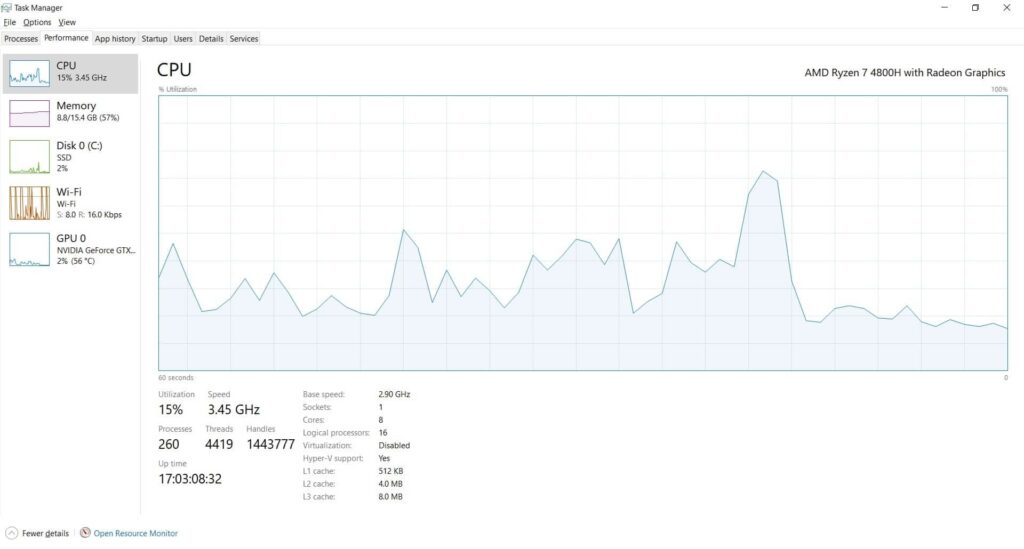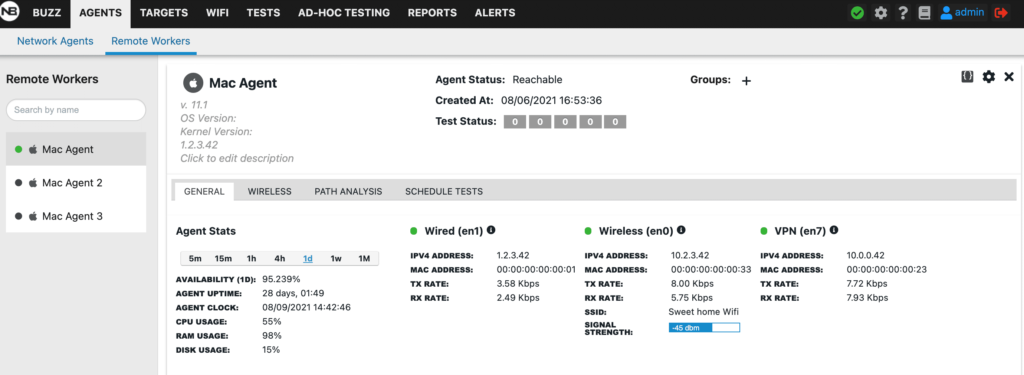Introduction
Prior to leading customer success at NetBeez, the majority of my IT experience was deeply rooted in computer design and performance, especially from an end-user perspective. I have personally built and/or tested over 1,000 performance oriented computers since 2011 logging hundreds of performance data metrics and direct feedback from the end users who use those systems. So this topic really hits home for me.
Memory Types
Before I dig into the topic of memory utilization, I’d like to list different types of memory that can be implemented in an operating system such as Windows:
- RAM/Memory: RAM is short for Random Access Memory but often referred to as memory. This is a much faster version of storage that is temporary. Your operating system and applications load in memory in a live state when called upon.
- In Use/Available Memory: These 2 should roughly equal your total memory and break down how much is in use and how much is available at any given time
- Cached Memory: Memory that is being held for programs that were recently used, this makes it so if you reopen an application it does not need to re-access it from the hard drive
- Reserved/Hardware Reserved Memory: This is memory that is blocked off from the system allocating to applications in reserve of important items such as BIOS related functions. If this is high (over 1GB), I recommend looking at fixes to reduce or eliminate this.
- Paged Pool: This is essential files/applications that can spill over into the page file (slower but still functioning)
- Non-Paged Pool: This is essential files/applications that NEED to stay in memory.Page File: Is a portion of the memory allocated specifically to important Operating System and other applications necessary for the PC to function. This usually ranges from 1-2GB of system memory.
Why is Memory Allocation Important?
In today’s world, we see a wide range of performance requirements for end-users in the business world. Some people are basic/light users while others are power users utilizing creative applications. While most business laptops either come with SSDs or have been upgraded to SSDs, we created a new bottleneck; memory and memory utilization.
Previously, even back in 2009/2010 with the birth of the Intel Core Series CPU, hard drives were the bottleneck. So it was very important for applications such as browsers, video conferencing and even games to be optimized as well as they could be. Then when SSDs went mainstream in the last decade for almost all applications, we are seeing memory utilization creep.
Applications now are built with the assumption that they will be run on an SSD, so they have become less and less optimized, more and more features being added and thus memory utilization is now a big issue and it is starting to plague Network Engineer’s day-to-day tasks.

This is a screenshot of my laptop and below are the following programs opened:
- 1 Zoom Call
- 1 Chrome window with 8 tabs with:
- YouTube
- Google Sheets
- HR Resource
- CRM
- Google search
- This google doc
- Microsoft Excel
- Notepad
- MS Paint
- Task Manager
And as you can see, this is a pretty powerful laptop with an 8 Core 16 Thread high performance CPU, a 512GB NVME SSD and 16GB of fast memory (3200MHz). And even with all of this, I am using over HALF (57%) of my memory.
How is this applied to the Help Desk?
Well, let us assume that I have 8GB of ram vs 16GB what would happen? Well first the PC would reduce the page file size in order to free up memory, but the Page file size on this PC is roughly 1.8GB. But we would start to get slower response times on browsing and internet traffic. Your device would have to constantly shuffle around things in and out of memory to maintain enough resources to execute the action that you’re asking.
So when the video training that your sales team needs to watch is buffering or even crashing, they open a ticket saying there is a network problem. If they are working remotely, that makes it even more difficult unless you have a remote agent installed on their device. And even if you do, what you’ll most likely find is that the network and the application is fine and you’ll most likely either bounce them to the Help Desk Team.
Proving more than just “it’s not the network”
So this is where things get tricky. Once you use NetBeez and prove that the web application and network are fine, you either create more work for yourself (The Network Engineer) or more work for someone else (Help Desk) to try and solve the users issue. But by the time you service the request, the user may have rebooted their machine which closed some nonessential apps and the application is working better (not perfect, but better). And you’ve spent some time trying to track down a ghost when you could have spent your time more efficiently.
When we announced internally that we were considering releasing a feature to monitor resource utilization for CPU, Memory & Disk Utilization – I was very excited. The goal of this feature is to log the current CPU, Memory and Disk utilization in 5 second intervals into the dashboard and overlay on the ping graph. Allowing your team to look back at any given time and compare network performance, web application performance and end-user device performance at the same time!
All that time chasing a ghost you can now not only prove It’s Not the Network, but the issue is resource utilization based, and can confidently either pass it to the person who handles those issues or solve it yourself quickly and efficiently. The last part of this feature that we are adding is, we are also displaying the current utilization stats in the dashboard under each agent. Upon receiving a new ticket, you can monitor their resources both in real time and historically. And this is WITHOUT taking any time away from the end-user!

Conclusion
As you can tell, I am extremely passionate about performance and user experience. Coming soon in Version 9.0, which is slated for Q4, some of my passion for user experience will be highlighted within our very own product. While I cannot take credit for the idea, our amazing development team accompanied with customer feedback (seriously, we love our customers so much!) really drive our growth and company direction.
I look forward to showing many of you this feature in our coming Quarterly Business Reviews and if you’re not a customer, we will have this feature available in beta to demo coming soon!





